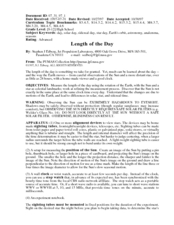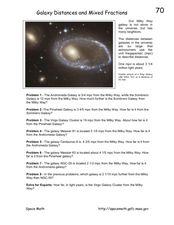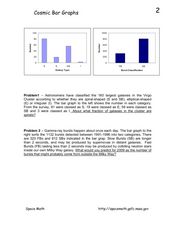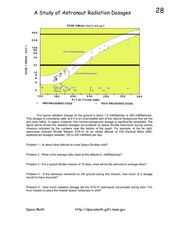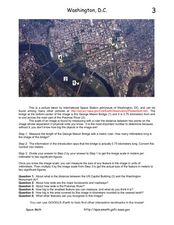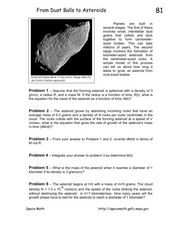Curated OER
How Big is a Lunar Crater?
In this lunar crater worksheet, students use an image taken by the Lunar Orbiter spacecraft to find the scale of the image and determine the diameter of the lunar crater Tycho. They also find the size of the smallest and largest features...
Curated OER
Program Your Partner
Students explore the world of robotics. In this robotics lesson, students study the history of robots and work with partners to find out how hard it is to accurately guide robots through simple tasks.
Curated OER
Make a Comet Model and Eat It!
Young scholars construct a comet model based on procedure provided. In this space science lesson, students compare the physical properties of comets to the models they made. They record their observations and share them with the class.
Curated OER
Length of the Day
Students investigate how the Earth's rotation affect the length of day. In this earth science lesson, students construct a sighting apparatus and record their observations over a few days. They analyze data collected and formulate a...
Curated OER
LRO Sees Apollo 11 on the Moon!
In this moon image learning exercise, students determine the scale of an image taken by the LRO satellite of the Apollo 11 landing site. Students calculate the sun's angle at the time of the photograph using the shadow of the Lunar...
Curated OER
Solar Storm Energy and Pie Graphs
In this solar storm energy and pie graphs instructional activity, students solve 5 problems using pie graphs that show the amount of solar energy that is converted into radiation, kinetic energy, flare energy and flare energy that is...
Curated OER
Groups, Clusters and Individuals
In this galaxies, clusters and planets worksheet, students solve 5 problems including determining sunspot groups on the sun in a particular day, finding the number of individual galaxies present, determining the number of stars in...
Curated OER
Counting Galaxies with the Hubble Space Telescope
For this counting galaxies worksheet, students use a photograph taken by the Hubble Space Telescope and they divide the field into 16 square areas. They find the average number of galaxies in the cells, they find the area of one of the...
Curated OER
Galaxy Distances and Mixed Fractions
In this galaxies and fractions worksheet, students solve 8 problems involving the distances of galaxies from each other by using mixed fractions to solve each problem. They use the megaparsec as the unit of measurement.
Curated OER
Cosmic Bar Graphs
In this cosmic bar graph worksheet, students solve 2 problems using given bar graphs that plot the number of galaxies vs. the galaxy type and the number of gamma-ray bursts vs. the burst classification. Students find the fraction of...
Curated OER
Stars and The Modern Telescope
In this stars and the modern telescope worksheet, students use a photograph taken by the 2MASS telescope to calculate the number of bright stars and faint stars in the picture, the size of the picture, and the number of stars expected to...
Curated OER
Carbon Dioxide Increases
In this atmospheric carbon dioxide instructional activity, learners use a graph of the Keeling Curve showing the increase in atmospheric carbon dioxide since 1958 to solve 6 problems. They determine the rate of increase, the find the...
Curated OER
THEMIS: A Magnetic Case of 'What Came First?'
In this magnetic reconnection worksheet, students solve seven problems using the data and graphs from the THEMIS satellite constellations, which show a series of events triggered by a magnetic reconnection. Students interpret the data in...
Curated OER
A Study of Astronaut Radiation Dosages
In this astronauts and radiation worksheet, students use a graph that shows the altitude of an astronaut versus the exposure to radiation to solve 5 problems. Students interpret the graph to express the amount of radiation at varying...
Curated OER
Calculating Black Hole Power
In this black hole learning exercise, students use a given equation that relates the rate of matter falling into a black hole to the power emitted by the black hole to determine accreted mass.
Curated OER
Washington D.C. from Space
In this Washington D.C. from space instructional activity, students use a picture generated by the International Space Station and they find the scale of the image. They determine the actual size of features in the image, they find the...
Curated OER
The International Space Station-Follow that Graph!
In this altitude change of the International Space Station learning exercise, students observe a graph of the change in altitude of the space station over time due to the Earth's drag. Students solve 3 problems using the data in the graph.
Curated OER
Indirectly Direct
Student form and test hyptheses using indirect and direct observation. They launch marbles to determine the shape of a hidden object.
Curated OER
Tag, You're Sick
Students play a game to model how the immune system works. In this health and wellness instructional activity, the teacher explains how the immune system works, then students play a game of tag trying to stay away from germs, viruses,...
Curated OER
Fractions in Space
In this fractions in space worksheet, students solve 4 problems where they find ratios of orbit periods of satellites, they find the ratio of Neptune's and Pluto's periods, they determine the location of the planets after 5 opposition...
Curated OER
Eagle Nebula - Close-up
In this Eagle nebula worksheet, students solve 4 problems including finding the size of the nebula field, determining the scale of the image, determining how large the nebula is in millimeters and determining the size of the smallest...
Curated OER
Hinode-Close Up of a Sunspot
In this solar sunspot worksheet, students use two photographs from the Hinode solar observatory showing a sunspot on the solar surface. Students solve 5 problems including finding the scale of the images, determining the smallest detail...
Curated OER
From Dust Balls to Asteroids
In this asteroids worksheet, high schoolers solve six problems where they find the equation for the mass of asteroids, they find the equation for the growth of asteroids, and they integrate their answers.
Curated OER
From Dust Grains to Dust Balls
In this formation of planets worksheet, students solve 6 problems including finding the equation for the mass of rocks as a function of time, finding the equation for the rate of growth of the mass of rocks and integrating these equations.





